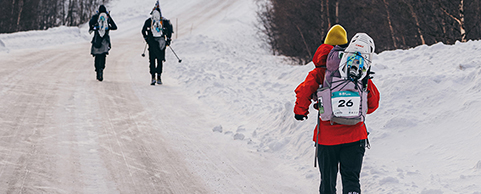Mountain Huts In Europe - What are they like?
This is the fourth post in a series by Bogong owner Neil about the Why, Where and How of hiking in the European Alps. It has been updated at Sept 2017.
See also:
- All About Walking in Austria
- Gear for Hut-to-hut walking in Europe
- Where to walk after the Tour Du Mont Blanc
- Walking in Norway
Hiking in the European Alps is a unique experience and the reason for this is directly due to the mountain hut system that straddles the alpine countries and is so much of the European walking culture. There is absolutely no parallel to them in Australia, or New Zealand for that matter, and as such I have found many well travelled Australian bushwalkers have no concept as to what is on offer. So this blog is to explain what they are like, the variations from country to country, and the culture of hut to hut walking that exists in Europe.
The huts could best be described as part hotel, part youth hostel and in fact not exactly like either. Hütte, Rifugio, Refuge, Cabane, Haus are just some of the names they could go by. The huts always offer dormitory type sleeping, where people of all types are placed in together. Some have individual rooms but these tend to be at a premium. They also have a full meal and beverage offering and are very reasonably priced. Meals are served in a guest room which doubles as a a general space to sit and chat. Most have some sort of outside terrace where you can sit and admire what is often an absolutely stunning view while sipping a beer or wine when the weather is good. What could be better?
In my experience the huts vary in character from country to country and I mention some specific differences below but all have some common characteristics.
In general a mountain hut has a Hut warden and staff. Hot meals are served and sleeping accommodation is provided that includes mattresses, pillows and blankets or doonas. It is compulsory to supply your own sleeping sheet and pillow case. A lightweight silk sheet with an integrated pillow slip is ideal. Drinks include beer, wine, soft drinks and tea, coffee and hot chocolate.
Sleeping accommodation always includes a dormitory option in which there is no segregation by sex or age. Whilst this is always warm and snug light sleepers will find them challenging to sleep in. Snoring, late bed goers or early risers are common as well as a night time procession to the bathroom. Be warned! Ear plugs are useful. Some huts offer the option of individual rooms which alleviate these problems but you should be aware that if there are 4 beds in your room and there are 2 of you the extra beds will be allocated to others if demand requires.
There are some un-manned huts in Europe and some shelter huts which are usually referred to as Bivouacs which are somewhat similar to our refuge huts. As in Australia there are no services in these huts but they often have mattresses.

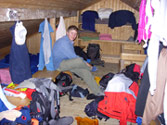
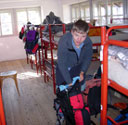
 From left: Typical dormitory, Very crowded dorm, Italian style metal bunks, Example of a separate room
From left: Typical dormitory, Very crowded dorm, Italian style metal bunks, Example of a separate room
Costs vary from country to country but are usually around the €22 mark for dorm accommodation. All alpine club huts from the various countries offer a discount to members, typically €10 and have reciprocal rights so you only have to belong to one club. For this to be worthwhile you need to be staying approximately 7 nights only. Moreover, membership of the Austrian Alpine Club at least includes €25,000 worth of search and rescue insurance worldwide. Be aware that unlike in Australia search and rescue is not a free service in Europe and with travel insurance these days having many exclusions this is a great benefit. I have personally been a member of the Austrian Alpine Club for at least 15 years.
See here for details:
Considering their location meals are very reasonably priced. Typically a main meal will be €8 - €14. Many offer a “half pension” option which is a fixed menu 3 course dinner (soup, main and dessert) and breakfast for ~ €26 which is probably the cheapest option for hearty eaters. Breakfast is often fairly basic and compared to the evening meal is poor value. It is usually possible to carry your own food and eat on the terrace but this somewhat destroys the point and it is not part of the local culture. However taking some muesli and powdered milk for breakfast is not a bad idea. Some huts offer lunch packs if booked in advance, but not always, and usually chocolate and snack bars are available for sale. It is a good idea to carry some lunch supplies such as cheese, biscuits and salami with you. Fruit is seldom on offer. A word of advice. It is simply not realistic to expect such basic establishments to be whipping up vegetarian or other special meals so go with the flow if possible, particularly if you are not fluent in the local language which I guess is most of us. The smaller the hut the more important this comment becomes.
BOOKING In general booking is not required if you are a small group of 3 or less. However smaller and private huts, particularly in France and Switzerland can be an exception. In France I would recommend booking all huts. In general booking one night ahead at a time is usually OK. Be aware that Friday & Saturday nights tend to be much busier so consider booking these. Huts on the Tour De Mont Blanc need to be booked well in advance. Hut wardens understand that travel in their environment is subject to the vagaries of mountain hazards and weather. Peak season is late July to late August and booking during this period is more likely to be required. Also huts that have direct road access or only a short walk from a roadhead (say 1 hour), tend to be busier and thus require booking. I have stayed literally hundreds of nights in huts and have only twice been turned away because the hut was full.UPDATE AUG 2018. BOOKING. After receiving further info from a variety of sources it appears that the huts are getting busier by the year and at least in the mid July to late August period booking in advance is strongly advisable and absolutely mandatory on weekends. It also appears the one day ahead rule mentioned above is less tenable than previously during the peak season. I was in Austria in September 2017 and found booking not essential then but the weather was bad.
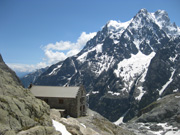


 Refuge du Glacier Blanc, France; Innsbrucker Hutte, Austria; Muttsee Hutte, Switzerland; Rifugio Prarayer, Italy
Refuge du Glacier Blanc, France; Innsbrucker Hutte, Austria; Muttsee Hutte, Switzerland; Rifugio Prarayer, Italy
Practicalities
FACILITIES
Typically there are men’s and women’s washrooms with basins and cold water only. An increasing number of huts also offer coin in the slot showers with hot water. The time varies depending on the availability of both water and electricity at the particular hut. Toilets are usually internal but be prepared for squat toilets in some places, particularly in France and Italy. The most basic facilities of any hut I stayed at was an outside trough for washing with an external drop toilet. However this was possibly the most welcoming hut I have stayed at and I enjoyed my stay immensely.
Recharging facilities for mobile phones and the like. Following a recent trip to Austria in 2017 it is apparent that most huts have responded to the demand for the ability to recharge electronic devices but it would be best to not rely on this at all huts. Around 80% of the huts I visited had readily accessible charging points. Conversely the ubiquitous mobile phone has meant that huts are now unwilling to ring ahead to the next hut to secure a booking on your behalf. They expect you to do it!
HUT SEASONS
Most have a season from mid-June to mid-September. More remote or higher huts may have a shorter season. Details for any particular hut can be found in the links at the end of this article. Some huts also have a skiing season which vary but could be Feb to April.
HOW ARE THE HUTS SERVICED?
Most huts are serviced by a road that typically may come up a valley to the hut. This road is often private. Higher huts often have a goods lift that runs from the valley. These simple structures often run improbable distances across large spans and are not approved for human use! The most remote huts are serviced by helicopter and you can expect an extra surcharge at these huts and rightly so. Electricity may be supplied by generators but more and more huts now have solar panels. A number of huts I have stayed at have mini hydro generators on a nearby stream or waterfall and I have been to at least one hut with bank of wind generators on the roof.
HUT RULES & ETIQUETTE
These may vary from hut to hut but the following are typical.
- Boots are never allowed in the sleeping areas and often not within the hut. There are either racks in the entrance hall or a boot room nearby. Likewise for walking poles and ice axes.
- In many huts you get a card on arrival on which a tally is kept of drinks and food. Accommodation is usually paid on arrival and the food and beverage bill is often settled in the evening before retiring. This includes breakfast for the next day.
- Cash only! Although there are now some exceptions to this huts seldom take credit card payment so you need to carry cash. Update 2017. After a recent trip in 2017 I can confirm that virtually all huts still have a cash only policy.
- If you book and don't make it please make every effort to contact the hut and cancel.
LANGUAGE REQUIREMENTS
No doubt you will quickly pick up basic greetings where ever you are and of course it is polite to learn these. I have never had difficulty in organising food and accommodation anywhere. France is the country where you most likely will meet resistance to requests in English and it is important in France to identify yourself as Australian as soon as you arrive at the hut and you will get a warmer welcome. English is widely spoken in Swiss, Austrian, Italian and Slovene huts.
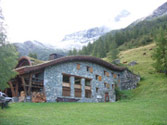
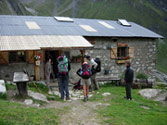
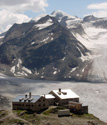
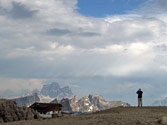 Rosuel Hut, France; Refuge Balma, France, Braunschweiger Hütte, Austria; Rifugio Lagazuoi, Italy
Rosuel Hut, France; Refuge Balma, France, Braunschweiger Hütte, Austria; Rifugio Lagazuoi, Italy
Variations by Region
FRENCH HUTS
In France there is a much higher proportion of private huts. These may be smaller. Alpine club huts tend to be larger. Huts on popular walks such as the Tour de Mont Blanc are large well-oiled operations capable of handling mind boggling numbers of visitors. Most French huts have no menu but offer only a fixed menu dinner and breakfast. In many of the high valleys a hut will be run by a farmer who is running stock in the surrounding valley. This can add considerably to the romance. For these huts it is wise to book at least on the morning you are heading that way and let them know you would like to eat. Typically the farmer’s wife will prepare one single dish so it is only fair to give advance warning of your arrival. Finally the food produced in some of these incredibly basic establishments has to be seen to be believed. The French are famous for their food and there is no doubt the French huts have the best food and take a great pride in it. I met a group of Germans walking in France once and on querying why they weren't walking nearer to home they said "the food is better here".
One last point on France. Many French alpine villages have an accommodation type called Gîtes d’Etape. Literally translated as House for Walkers these establishments could best be described as mountain huts in a village. Sleeping often remains in dorms but hot showers are standard. Menus are set but the food is magnificent. It is possible to do a walking tour in places from Gîte to Gîte.
SWISS HUTS
Swiss huts vary in size and style perhaps more than anywhere else. From tiny little establishments to almost full on guest houses. Everything in Switzerland is more expensive than in the other countries. The Swiss are very fussy about keeping their huts clean and it is a brave walker who will wander into the matron of the house’s dining room with their boots on.
AUSTRIAN HUTS
Because of the incredibly powerful influence of the German and Austrian Alpine clubs there is a higher proportion of club huts in Austria than anywhere else. The clubs enforce rigorous standards so the level of service and pricing is quite uniform. Austrian Huts always offer an a la carte menu and will usually serve lunch meals as well as dinner. Alpine club rules mean these huts will never turn anyone away unless there is a viable option nearby, even if they have to put a mattress on the floor of the dining room. Well appointed and comfortable Austrian huts serve the requirements of their visitors very well. These comments also apply to German Huts.
ITALIAN HUTS
In many respects Italian huts are similar to their Austrian counterparts. They are often a little more run down and dorm sleeping can be in somewhat rickety bunks. However food is good and wine is cheap. Drink wine in Italy and beer in Austria is a good rule. Many Italian huts are in quite remarkable locations.
SLOVENIAN HUTS
The Slovenes love their mountains and thus many of their huts are particularly large and thus somewhat impersonal places. Nevertheless the services they offer are good and accommodation is very comfortable.
PYRENEAN HUTS
The Pyrenees has a hut network. However walkers in this range need to be aware that the network is not as extensive as elsewhere in the Alps so it is not always possible to select a true hut to hut route for longer walks. So it may be necessary to retreat to the valleys or carry your tent and camping gear. There are still plenty of multi day walk options, more planning is needed, that’s all.
NORWEGIAN HUTS
Since I have also walked in Norway a note on Norwegian huts. The Norwegians have a simply superb hut system. High quality huts and many of them in the mountain areas. Standards are of the highest order and meals are high quality and huge amounts of food. Breakfasts are typically an extensive buffet and included in the price you may make a cut lunch from the breakfast buffet. However prices for food and lodgings are double that for continental huts. See more at Walking in Norway
There are also serviced huts in the Tatra mountains of Slovakia, the Balkan countries, Romania and no doubt elsewhere. As I have not hiked in these countries - you will have to investigate these yourself.
ROMANIAN HUTS
Update 2015. Having now spent two weeks hiking in Romania in the Carpathian mountains I can now comment on huts in Romania. They offer the same basic services as huts throughout the rest of Europe but are much more basic. Meals are basic and variable. An example would be pork and potatoes means a fried piece of frozen pork with mashed potato made from potato powder (Deb). Mattresses at times looked like they were older than me and I noticed that the locals habitually carry therm-a-rest style mats to put on top of the bunk. Lesson learned. Washing facilities may well be in the stream outside the hut. Having said that, like huts elsewhere in Europe they offer warmth, food and shelter to the weary hiker.
Useful Links:
All the below Alpine Club sites have lists and links of their individual huts. Sites are mainly in the native language only but google translate will help you get around.
Austrian Alpine Club (ÖAV): www.alpenverein.at
Austrian Alpine Club UK Section: https://www.alpenverein.at/britannia/
German Alpine Club: www.alpenverein.de
French Alpine Club: www.ffcam.fr
Swiss Alpine Club: www.sac-cas.ch
Italian Alpine Club: www.cai.it
Norwegian Trekking Association http://english.turistforeningen.no/ In English
Refuges and Bivouacs of Italy: http://rifugiebivacchi.cailugo.it
Gites d’étape et Refuges: www.gites-refuges.com
Slovenia: https://en.pzs.si/ Not the easiest site to use. Have patience.
Many huts have their own websites. For example a simple google search for “Friesenberghaus” one of the huts featured in the video above will lead you to www.friesenberghaus.com
See also the blog:
The European Alps - A long walk
European walking is much enhanced by the mountain hut experience. Go out and discover it!

This is the fourth post in a series by Bogong owner Neil about the Why, Where and How of hiking in the European Alps.
See also:


















